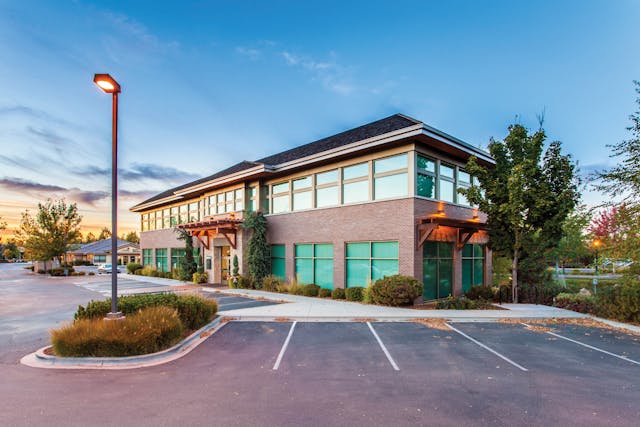In a competitive business, first impressions hold immense sway. Potential customers often form their initial perceptions based on a company’s exterior appearance, and a well-maintained parking lot with appealing landscaping can significantly influence these impressions. A business that prioritizes curb appeal conveys a sense of professionalism, attention to detail, and pride in its establishment. This, in turn, can attract more customers, boost employee morale, and even increase property value.
Landscaping is a powerful tool for transforming a mundane parking lot into an inviting and visually appealing space. Strategically placed trees, shrubs, and flowers can soften the harsh lines of asphalt and concrete, creating a more welcoming environment. Greenery enhances aesthetics and provides numerous environmental benefits, such as reducing the urban heat island effect, improving air quality, and managing stormwater runoff. Moreover, thoughtful landscaping design can guide traffic flow, define parking areas, and create a safer, more organized lot.
Table of Contents
Planning Your Parking Lot Landscaping
Before embarking on a landscaping project, assessing your parking lot’s existing layout is crucial. Take note of the total area, number of parking spaces, traffic flow patterns, and any pre-existing landscaping elements. Consider the condition and visibility of your parking lot striping, as clear and well-maintained striping is essential for organizing traffic flow and ensuring safety. Faded or worn striping can lead to confusion and accidents, detracting from your lot’s overall appearance and functionality. Identify areas that could benefit from adding greenery, such as entranceways, pedestrian walkways, and islands between parking rows. Consider how your landscaping plan can complement and enhance your parking lot striping, creating a cohesive and visually appealing design. This assessment will provide a solid foundation for building a tailored landscaping plan that optimizes aesthetics and functionality.
Your parking lot landscaping should align with your business’s overall style and brand identity. A cohesive design that complements the architectural features and color scheme of your building creates a seamless and professional appearance. For instance, a modern, minimalist office building might opt for clean lines and geometric plantings, while a rustic, farm-to-table restaurant may prefer a more organic, naturalistic landscape design. Incorporating brand elements, such as colors or logos, can further reinforce your business’s identity and make a lasting impression on visitors.
Establishing a clear budget is essential for ensuring the success and sustainability of your parking lot landscaping project. Consider both the initial installation costs and the ongoing maintenance expenses. Factors that influence the budget include the size of the lot, the complexity of the design, the types of plants and materials used, and whether you will hire a professional landscaping company or tackle the project in-house. Investing in high-quality, low-maintenance landscaping can provide long-term benefits and cost savings compared to cheaper, short-lived alternatives.
Choosing the Right Plants
When selecting plants for your parking lot landscaping, prioritize low-maintenance options that can thrive in your location’s specific conditions, such as sunlight exposure, soil type, and average temperatures. Opt for drought-tolerant plants that are resilient to pollution and salt and require minimal pruning and fertilization. Native plants are an excellent choice as they are naturally adapted to the local climate and soil conditions, making them more resistant to disease and pest issues while requiring less water and fertilizer. Drought-resistant plants, such as lavender, rosemary, and yucca, are ideal for areas with limited rainfall or water restrictions. These hardy, water-wise options can help you create a sustainable, eco-friendly landscaping design that reduces maintenance costs and environmental impact.
In addition to low-maintenance and native plants, consider including a diverse mix of trees, shrubs, and flowers to add depth, texture, and visual interest to your parking lot landscaping. Trees provide valuable shade, reduce the urban heat island effect, and create a sense of scale and structure. Shrubs can define borders, screen unsightly views, and guide pedestrian traffic, while flowers in beds or planters inject vibrant pops of color and seasonal interest. When choosing plants, it is crucial to consider their mature size to ensure they will fit comfortably within the designated spaces once fully grown. Refer to plant labels or consult a landscaping professional to understand the expected mature heights and widths of the species you are considering. By planning for the future size of your plants and selecting a diverse mix of low-maintenance, native, and drought-resistant options, you can create a parking lot landscape that remains functional, attractive, and sustainable for years to come.
Strategic Plant Placement
Create a strong visual impact at your parking lot entrance by installing a striking plant arrangement, such as colorful annuals or a sculptural evergreen shrub. Flank the entrance with symmetrical plantings and incorporate signage or lighting elements to enhance visibility and brand recognition. Soften the hard edges and corners of your parking lot by strategically placing a combination of low-growing groundcovers, mounding shrubs, and ornamental grasses, and consider using curved planting beds to break up the linearity and introduce visual interest.

Incorporate shade trees to reduce pavement temperature, provide vehicle shelter, and minimize the urban heat island effect. Select species with high canopies for clear sightlines and unobstructed pedestrian movement, and opt for deciduous trees to allow sunlight penetration during colder months. Maintain clear sightlines for safety by considering plant mature heights, avoiding obscuring traffic signs or pedestrian crossings, and regularly pruning trees and shrubs to remove low-hanging branches or overgrown foliage.
Hardscaping Elements
In addition to plants, hardscaping elements can add visual interest and functionality to your parking lot landscaping. Incorporating decorative rocks or gravel into planting beds can provide a low-maintenance, drought-tolerant alternative to traditional mulch. Choose stones that complement the color scheme of your building and landscaping, such as river rocks, crushed granite, or slate chips. Gravel can also create permeable surfaces for improved drainage and stormwater management. When installing hardscaping elements, ensure they are appropriately contained and do not spill onto the parking lot surface, which could pose a tripping hazard.
Protecting your parking lot landscaping from vehicle damage and foot traffic is essential for maintaining its appearance and longevity. Installing curbs or barriers around planting beds can prevent cars from driving over plants and minimize soil compaction. Concrete curbs, metal edging, or decorative bollards can define the boundaries of your landscaping and guide traffic flow. When selecting barriers, consider their durability, aesthetics, and ability to withstand potential impacts. Properly installed and maintained barriers safeguard your landscaping investment and contribute to the overall organization and visual appeal of your parking lot.
Incorporating seating areas into your parking lot landscaping can enhance the functionality and comfort of the space. Benches or other seating options allow visitors to rest, wait for transportation, or enjoy the outdoors. Strategically place benches near the building entrance, in shaded areas, or alongside pedestrian walkways. Choose seating materials that are durable, weather-resistant, and easy to maintain, such as metal, concrete, or recycled plastic. Integrate seating areas into the landscape by surrounding them with attractive plantings or hardscaping elements. By offering seating options, you can create a more inviting and user-friendly parking lot experience.
Proper Irrigation and Drainage
Proper irrigation is crucial for the health and longevity of your parking lot landscaping. Installing an efficient irrigation system ensures that your plants receive the right amount of water while minimizing waste and reducing labor costs. Consider a drip irrigation system, which delivers water directly to the root zone of the plants, reducing evaporation and runoff. Alternatively, a low-volume spray system can provide adequate coverage for more extensive planting beds. Incorporate smart controllers or moisture sensors to automatically adjust watering schedules based on weather conditions and plant needs. Regularly inspect and maintain your irrigation system to promptly detect and repair any leaks or malfunctions.
Adequate drainage is essential for preventing water pooling and potential damage to your parking lot and landscaping. Standing water can lead to pavement deterioration, soil erosion, and plant root rot. When designing your landscaping, ensure that planting beds have proper grading and slope to allow for water runoff. Install catch basins or drainage channels in low-lying areas to collect and redirect excess water. Consider using permeable pavers or porous asphalt in specific parking lot sections to allow for better water infiltration. Regularly clean and maintain drainage systems to prevent clogs and ensure optimal performance.
Applying a layer of mulch to your landscaped areas offers multiple benefits for your parking lot. Mulch helps retain soil moisture, reducing the need for frequent irrigation and protecting plants from drought stress. It also suppresses weed growth, minimizing the need for herbicides and manual removal. Organic mulches, such as bark chips or shredded leaves, break down over time, adding nutrients to the soil and improving its structure. When applying mulch, maintain a 2-3 inches depth, and avoid placing it directly against tree trunks or plant stems to prevent moisture-related damage. Replenish the mulch layer annually to maintain its effectiveness and attractive appearance.
Regular Maintenance
Regular maintenance ensures the health, safety, and aesthetic appeal of your parking lot landscaping. Establish a routine schedule for pruning and trimming, considering each plant species’ specific needs. Prune trees to remove dead, damaged, or crossing branches and to maintain clear sightlines and pedestrian access. Trim shrubs to control their size, shape, and density, promoting healthy growth and preventing encroachment onto parking spaces or walkways. Regularly inspect plants for signs of disease or pest infestation, such as discoloration, wilting, stunted growth, or abnormal leaf damage. If you notice any concerning signs, promptly identify the problem and take appropriate action, such as pruning affected areas, applying targeted treatments, or seeking professional assistance. By catching and addressing issues early, you can minimize damage to your landscaping and ensure its long-term vibrancy.
In addition to maintaining your plants’ health, keeping your parking lot clean and well-maintained is essential. Regularly remove fallen leaves, branches, and other organic matter that can accumulate in planting beds, as these can harbor pests and diseases and hinder plant growth. Promptly dispose of any trash or debris that visitors may discard, as this can detract from the overall appearance and give an impression of neglect. Establish a routine cleaning schedule and assign responsibilities to your maintenance team to ensure consistent upkeep. Furthermore, keep your parking lot striping clear and visible to ensure proper traffic flow, enhance safety, and contribute to the overall aesthetic appeal of your parking lot. Regularly inspect your striping for signs of wear, fading, or damage, and schedule repainting as needed, particularly for ADA-compliant spaces, fire lanes, and other critical markings. Maintaining a tidy and well-kept parking lot landscape and ensuring clear striping demonstrates your commitment to providing a safe and visually appealing environment for your customers and employees.
Seasonal Considerations
Incorporating annual plants into your parking lot landscaping can provide vibrant pops of color and seasonal interest. Annuals are plants that complete their life cycle within one growing season, allowing for flexibility and creativity in your landscape design. Choose annuals that are well-suited to your climate and the specific conditions of your parking lot, such as sun exposure and soil type. Consider plants with bold, eye-catching colors like petunias, marigolds, or snapdragons to create visual impact and draw attention to critical areas—plant annuals in masses or coordinated color schemes for a cohesive and striking display.
In addition to annuals, consider changing out other plants in your parking lot landscaping to provide seasonal interest throughout the year. This can involve replacing spent perennials or shrubs with new selections that offer color, texture, or fragrance specific to the current season. For example, in spring, incorporate bulbs like tulips or daffodils for a burst of early color, while in fall, plant ornamental grasses or autumn-hued foliage for a warm and inviting atmosphere. Regularly refreshing your plantings keeps your landscaping looking vibrant and demonstrates a commitment to ongoing care and attention to detail.
Preparing your parking lot landscaping for the winter months is important for protecting your plants and ensuring a smooth transition into the next growing season. Before the first frost, remove any dead or dying annuals and prune perennials back to their base. Apply a fresh layer of mulch around plants to insulate the soil and protect roots from freezing temperatures. For young or sensitive trees, consider wrapping the trunks with burlap or using tree guards to prevent snow, ice, or wildlife damage. Adjust your irrigation system to account for reduced watering needs during dormant periods, and drain or winterize any components that could be damaged by freezing. By taking these proactive steps, you can help your landscaping weather the winter months and emerge healthy and vibrant in the spring.
Conclusion
Invest in your business’s image and functionality with a well-designed parking lot landscape. Strategic greenery and hardscaping enhance curb appeal and create a welcoming environment, improve traffic flow, promote sustainability, and boost employee morale. From selecting low-maintenance plants to incorporating proper irrigation, this guide provides everything you need to transform your parking lot into an asset that reflects your professionalism.




